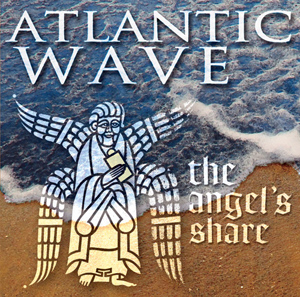

MUSIC OF IRELAND, SCOTLAND & CAPE BRETON
LISTEN TO ATLANTIC WAVE
- Song: Garret Scary's
- Album: Craic'd!

Craic'd!
Click track name for song and tune details.
Garret Barry's/Paddy O'Rafferty's/McFarley's/Boys of Malin
This set, brewed in Kaitlin's basement in February of 2005, and now our favorite set to open with at gigs, begins with two old favorite jigs: Garret Barry's and Paddy O'Rafferty's. Two Donegal reels round off the set.
Includes the reel Moving Cloud in interludes.
A classic Scottish ballad with lyrics in the Scots language, inspired by the Scottish band Old Blind Dogs version, whose liner notes led Barry to the book Ord's Bothy Songs, a source of many great songs. In this one, the singer imagines all of the good things he'd have if he were a beggar.
The Earl of Dalhousie's Happy Return to Scotland/Athol Brose/Silver Spear/Sheehan's
This first tune has been a favorite of Ed and Kaitlin's for years. Athol Brose strathspey is a staple amongst Scottish and Cape Breton fiddlers. The Silver Spear reel is a blast to play and is known by Irish musicians the world over. A leap to the key of G brings us to the vertex — Sheehan's Reel.
New World Symphony Theme/Dusty Miller
Although he never really made it to Donegal, Dvořák's penchant for folk music did bring him to the US. Suggesting that at least one theme from his New World Symphony has an Irish flavor, we've paired it with Donegal slip jig, Dusty Miller.
This song is an Andy Stewart masterpiece which has inspired so many great versions by other bands. This is Barry's version. The intro is the old English song The NonesuchThe intro is the old English song The Nonesuch.
The Northwoods (Kaitlin Hahn)/Iron Man/Peter Street/Cloch Na Ceithre Mhile (The Low Reel)/Big John MacNeil
Kaitlin composed the first strathspey, The Northwoods, after visiting her grandpa in Boulder Junction, Wisconsin. The Iron Man strathspey was composed by J. Scott Skinner. A performance of Peter Street exists on season 5, episode 9 of the classic 80s TV show Hart to Hart. Cloch Na Ceithre Mhile reel can be found on Mairead Ni Mhaonaigh and Frankie Kennedy's album, Ceol Aduadh. Big John MacNeil reel finishes off our "big set".
This song is an old Scottish favorite. This version was inspired by the very short version on 100 Great Scottish Songs by Phil Cunningham.
Midlothian Pipe Band/Drover's Lads
A selection of jigs to honor the late Johnny Cunningham. He was a virtuoso fiddler with a sense of humor (while attending a weeklong fiddle camp, Ed never saw him parted from his life-sized inflatable "Gumby"). Kaitlin learned the second tune from the playing of Stan Chapman. The Drover's Lads was expertly performed on Cunningham's Fair Warning album.
Paddy's Rambles Through the bPáirc
bPáirc = Irish for "farm field".
A very old air from the repertoire of the late Johnny Doherty. The story Johnny used to tell was of a fiddle player who chased a singing banshee all night in order to learn her haunting tune. Johnny learned it from the lilting of his great-grandmother, Nanny MacSweeney.
Another great Scottish bothy song. This version was inspired by the recording by Scottish band Wolfstone. It recalls the joys of working on the farm for "old Mitchell".
King of the Fairies/House of Hamill (Ed Reavy)/Touching Cloth (James Kelly)
Recorded by the screaming electric guitars of Horslips in 1974, King of the Fairies set dance has been popular among Irish musicians ever since. The second tune, House of Hamill, a reel, was penned by "the plumber of the bagpipes," Ed Reavy. Clare fiddler James Kelly composed Touching Cloth (a reel). (Johnny Cunningham named the tune.)
Tullochgorum/The Mouth of the Tobique
Only the crême de la crême of Cape Breton fiddle players venture to tackle the strathspey Tullochgorum. This first tune, played by Kaitlin, consists of a traditional Scottish melody with lengthy variations composed by fiddler J. Scott Skinner. The lads join in the fun with a French Canadian reel, The Mouth of the Tobique.
Tico Tico No Fuba (Tico Tico Bird in the Cornmeal) by Zequinha Abreu.
Popularly known as Tico, Tico, this gem was conceived as an instrumental by Zequinha Abreu in 1932. In 1942 Ervin Drake put the tune to words. In 2005, Kaitlin arranged the tune for fiddle! Get out the cornbread and check out this tune from "south of Ireland".
This is an Irish song that is believed to date from the mid-1700s. It laments the passing of a once-great manor called Portmore, and its great tree, which was said to have blown down in a storm.
Spey in Spate/Silver Slipper/The Mooncoin Reel
We learned the first reel, Spey in Spate, from the playing of Natalie MacMaster. The acropetal slip jig, Silver Slipper, was recorded by Paul O'Shaughnessy on his album Stay Another While. A familiar segue leads us into The Mooncoin Reel, a tune favored by Sean McGuire.

